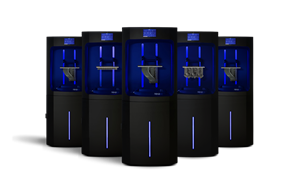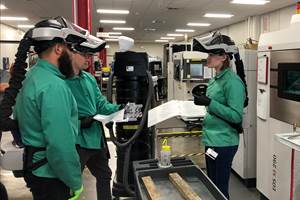Implementing Additive Manufacturing: Is the Juice Worth the Squeeze?
Is the end result of metal AM worth the effort it requires? Students of UL AMCC learn to ask this question at every stage in the process.
Although UL is known as an authority on safety, its Advanced Training on Metal Part Production course is more than just safety training. The class, offered at the UL Additive Manufacturing Competency Center (UL AMCCC), covers the entire 3D printing ecosystem within a company.
Each student leaves with an understanding of all the necessary steps to make a metal 3D printed part. In addition to learning how to run, load and unload the machine, students also learn how to receive, test and manage the material; maintain the machine and periphery equipment such as wet separators; and manage waste.
An expression commonly used during UL training encompasses this valuable lesson: “Is the juice worth the squeeze?”
“When working with 3D printing, end users should always be evaluating whether the end result is worth the effort required to obtain it," says Jon Walker, CMTSE, an area sales manager for EOS of North America who has taken the class. An expression commonly used during UL training encompasses this valuable lesson: “Is the juice worth the squeeze?”
"This thought process applies to everything from part design to support structure allocation to postprocessing,” says Walker. Here’s how that process plays out in some of the key stages in additive manufacturing.
Key Stages in the Additive Manufacturing Workflow
Postprocessing
Metal AM parts have a greater amount of postprocessing compared to plastic AM parts, and that needs to be considered from the very beginning in their design. “The challenge here is that if you don’t think about the downstream processes when you are setting up the build or designing the CAD, you are setting up the entire manufacturing chain for failure,” says Ed Tackett, director of educational programs at the UL AMCC.
The course reviews what actually has to happen to link metal AM to the CNC shop, and how the parts benefit. Working with the machine shop and postprocessing team to develop a design can result in a part that needs less cleanup or is easier to set up in a milling machine, for example. Also, consider what will be necessary to machine the part after it is printed, such as soft jaws, and how to provide them to the postprocessing team.
Support Structure Setup
Walker says that one of the most intimidating aspects of DMLS is support structure setup. “The UL training helped me understand the logic built into the Magics software for auto-generation of support structures and how important it is to think about postprocessing requirements when setting up the support structures," he says. “This permits a setup with minimal build time and efficient postprocessing requirements.”
Developing Design Allowables Packabe
The course also helps students develop their design allowables package on AM systems. “Each material for every machine builds a little differently, so students are shown how to figure it out on their own machine(s)," Tackett says. "We provide CAD files, instructions to build them and how to evaluate the results to ensure design engineers know what they can and cannot build at their facility on their equipment. This way, they can channel that information back upstream to the engineers to avoid designing parts that the machine can’t build."
Manage Expectations
Expectations are also discussed. Metal AM's roots are in metalworking, so metalworking, CNC machining, turning and polishing must be understood before attempting to institutionalize AM within a company. However, CNC machining can often be set up and run the next day to make production parts, and that is not the case with AM.
“Many people walk a show like IMTS, see a metal AM machine and think ‘We make metal parts. We should buy one of these.' They buy one and then drop it on the engineer with the same expectations of a CNC machine,” says Paul Bates, general manager of UL AMCC services. By better understanding the full process up front, companies can make better decisions about whether the "squeeze" is worth it.
Related Content
How to Improve Polymer AM Productivity 20X
A fast cycle time is critical to efficient production 3D printing, but it’s not the only thing. How you choose the right parts for AM, prepare jobs for production, and manage post processing will have just as big an impact on total 3D printing throughput. It all needs to work together to achieve maximum productivity.
Read MoreHow to Pursue a Career in Additive Manufacturing
AM professionals are in demand as 3D printing matures and advances. But what skills are hiring manufacturers looking for? How can applicants prepare? And where can you find relevant job listings?
Read MoreHow to Build 10,000+ Shot Molds in Hours
Rapid tooling isn’t so rapid when it takes days to 3D print a metal mold, and then you still must machine it to reach the necessary tolerances. With Nexa3D’s polymer process you can print a mold in hours that is prototype or production ready and can last for more than 10,000 shots.
Read MoreWhat is Powder Bed Fusion 3D Printing?
Whether in metal or polymer, with a laser or an electron beam, powder bed fusion (PBF) is one of the most widely used 3D printing techniques.
Read MoreRead Next
At General Atomics, Do Unmanned Aerial Systems Reveal the Future of Aircraft Manufacturing?
The maker of the Predator and SkyGuardian remote aircraft can implement additive manufacturing more rapidly and widely than the makers of other types of planes. The role of 3D printing in current and future UAS components hints at how far AM can go to save cost and time in aircraft production and design.
Read More3D Printing Brings Sustainability, Accessibility to Glass Manufacturing
Australian startup Maple Glass Printing has developed a process for extruding glass into artwork, lab implements and architectural elements. Along the way, the company has also found more efficient ways of recycling this material.
Read MoreHybrid Additive Manufacturing Machine Tools Continue to Make Gains (Includes Video)
The hybrid machine tool is an idea that continues to advance. Two important developments of recent years expand the possibilities for this platform.
Read More





















